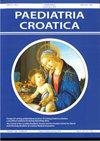PET/CT in diagnosis and monitoring the effect of treatment in children with malignant tumors
Q4 Medicine
引用次数: 0
Abstract
PET/CT is the most sensitive and highly specific imaging technique for determining the location of tumors, primary tumors of unknown location, determining the extent and activity of malignant disease, monitoring treatment effects, detecting local recurrence and distant malignancy, precise planning of various treatment modalities and planning/determining the radiation field. PET uses biologically active molecules labeled with short-lived radionuclides that emit positrons and are the product of nuclear reactions in a cyclotron. Fluorine-18 (18F) is the most commonly used radionuclide in nuclear medicine, and its relatively long half-life of 110 minutes allows adequate synthesis of radiopharmaceuticals and monitoring of biological processes, as well as delivery to PET machines in remote facilities. The most commonly used radiopharmaceutical, which is now used in clinical practice in more than 90% of PET/CT examinations, is 2-(18F)-fluoro-2-deoxy-D-glucose (18F FDG), a glucose derivative that reflects the accumulation and consumption of glucose in cells, i.e. glucose metabolism. PET/CT has an advantage over other diagnostic imaging techniques because by combining PET, which is the evaluation of the intensity of the metabolic activity of a specific radiopharmaceutical in the cells, and CT, which shows the anatomy and morphology of the organs, we simultaneously obtain information about pathological abnormalities in both the function and morphology of the lesions or organ and the presence of viable tumor or inflammatory tissue. It is important to mention that with the latest PET/CT equipment we have the possibility to visualize metabolic activity even in very small lesions (2 mm). The advantage of this diagnostic method is that the findings are not only analyzed visually, but also quantitatively by measuring the intensity of radiopharmaceutical accumulation in the lesions, thus achieving objectification of the findings and the possibility of adequately monitoring the effect of different forms of treatment in control imaging. PET/CT allows us to identify prognostically risky patients and to select the most appropriate forms of treatment for each individual patient. PET/CT is the most sensitive method for distinguishing treatment-related changes from residual or recurrent disease. A continuous decrease in metabolic activity in the tumor area indicates a positive effect of the treatment. PET/CT enables precise monitoring of the effect of all forms of treatment (surgical, chemotherapeutic, radiotherapeutic and radiosurgical procedures) and has the advantage that the entire body is captured and analyzed with one image in the field of view and not just a single segment. The radiation exposure in PET/CT results from the use of radiopharmaceuticals and CT imaging, and the ALARA principle (as low as reasonably achievable) is followed, whereby the dose is adjusted taking into account the weight and age of the child and the type of device, taking into account the longer life and radiation sensitivity of the child's organism.To assess the treatment effect, the RECIST criteria (Response Evaluation Criteria in Solid Tumors) are used to evaluate the size of the lesions and the PERCIST criteria (PET Response Criteria in Solid Tumors) to evaluate the metabolic activity of the lesions. Inclusion should also take into account the characteristics of the pediatric population, such as the need for parental or guardian consent for the examination, the period of starvation before the examination, etc., difficulties in establishing venous access, sedation/anesthesia of young children due to the need for rest during imaging, and marked physiological accumulation of radiopharmaceuticals in different parts of the body.Compared to adults, there is a slightly higher percentage of total accumulation of radiopharmaceuticals in the brain, lower excretion of activity in the urine, greater accumulation in the bone marrow due to more pronounced hematopoiesis, greater accumulation in regions with lymphatic tissue, pronounced physiological accumulation in growth zones, greater accumulation in brown adipose tissue, greater accumulation in the thymus (physiological, after chemotherapy), while the use of hematopoietic growth-promoting factors can lead to a pronounced diffuse accumulation of activity in the spleen and bone marrow. PET/MR offers a safer, more specific and more efficient assessment of the extent of disease in children than any other diagnostic imaging technique. The advantage over other hybrid diagnostic procedures is that a high resolution and a high contrast between diseased and healthy tissue is achieved with significantly less exposure to ionizing radiation. Artificial intelligence tools are now used to process the image data and analyze the findings, which improve image quality and perform the most accurate data reconstruction and support the physician in the search for suspicious lesions, measuring and determining the etiology of pathological processes in comparison with earlier diagnostic methods, and reducing the possibility of overlooking suspicious lesion.PET/CT 用于诊断和监测儿童恶性肿瘤患者的治疗效果
PET/CT 是最灵敏、特异性最高的成像技术,可用于确定肿瘤位置、位置不明的原发性肿瘤、确定恶性疾病的范围和活动性、监测治疗效果、检测局部复发和远处恶性肿瘤、精确规划各种治疗方式以及规划/确定辐射场。正电子发射计算机断层显像(PET)使用短寿命放射性核素标记的生物活性分子,这些分子发射正电子,是回旋加速器中核反应的产物。氟-18(18F)是核医学中最常用的放射性核素,它的半衰期相对较长,为 110 分钟,可用于合成放射性药物和监测生物过程,也可输送到远程设施中的 PET 机。最常用的放射性药物是 2-(18F)-氟-2-脱氧-D-葡萄糖(18F FDG),它是一种葡萄糖衍生物,可反映细胞中葡萄糖的积累和消耗,即葡萄糖代谢。PET/CT 与其他诊断成像技术相比具有优势,因为通过将 PET(评估特定放射性药物在细胞中的代谢活动强度)与 CT(显示器官的解剖和形态)相结合,我们可以同时获得病变或器官功能和形态的病理异常信息,以及是否存在有活力的肿瘤或炎症组织的信息。值得一提的是,利用最新的 PET/CT 设备,我们甚至可以观察到非常小的病灶(2 毫米)的代谢活动。这种诊断方法的优势在于,不仅可以对检查结果进行直观分析,还可以通过测量病灶中放射性药物的蓄积强度进行定量分析,从而实现检查结果的客观化,并能在对照成像中充分监测不同形式治疗的效果。PET/CT 使我们能够识别预后有风险的病人,并为每个病人选择最合适的治疗方式。PET/CT 是区分治疗相关变化与残留或复发疾病的最灵敏方法。肿瘤区域代谢活动的持续下降表明治疗效果良好。PET/CT 可以精确监测各种形式治疗(手术、化疗、放疗和放射外科手术)的效果,其优势在于通过视野中的一幅图像而不仅仅是单个部分来捕捉和分析整个身体。PET/CT 的辐射量来自于放射性药物的使用和 CT 成像,并遵循 ALARA 原则(尽可能低),即根据儿童的体重、年龄和设备类型调整剂量,同时考虑到儿童机体的寿命较长和对辐射的敏感性。为了评估治疗效果,采用 RECIST 标准(实体瘤反应评估标准)评估病灶的大小,并采用 PERCIST 标准(实体瘤 PET 反应标准)评估病灶的代谢活动。纳入时还应考虑到儿科人群的特点,如检查是否需要家长或监护人同意、检查前的饥饿期等、在建立静脉通路方面的困难、由于成像时需要休息而对幼儿进行镇静/麻醉,以及放射性药物在身体不同部位的明显生理性蓄积。与成人相比,放射性药物在大脑中的总蓄积量比例略高,尿液中的放射性活度排泄量较低,骨髓中的蓄积量因造血功能较强而较高,淋巴组织区域的蓄积量较高、而使用造血生长促进因子会导致活性在脾脏和骨髓中明显弥漫性积累。与其他影像诊断技术相比,PET/MR 能更安全、更具体、更有效地评估儿童的疾病程度。与其他混合诊断程序相比,PET/MR 的优势在于可实现高分辨率以及病变组织与健康组织之间的高对比度,同时显著减少电离辐射暴露。
本文章由计算机程序翻译,如有差异,请以英文原文为准。
求助全文
约1分钟内获得全文
求助全文
来源期刊

Paediatria Croatica
医学-小儿科
CiteScore
0.20
自引率
0.00%
发文量
0
审稿时长
6-12 weeks
期刊介绍:
In the inaugural 1956 issue of the journal, the editor Dr Feđa Fischer Sartorius outlined the journal''s vision and objectives saying that the journal will publish original papers on the development, pathology, and health care of children from the prenatal period to their final biological, emotional and social maturity. The journal continues this vision by publishing original research articles, clinical and laboratory observations, case reports and reviews of medical progress in pediatrics and child health.
 求助内容:
求助内容: 应助结果提醒方式:
应助结果提醒方式:


